 W
WThe first encirclement campaign against the Honghu Soviet was an encirclement campaign launched by the Chinese Nationalist Government that was intended to destroy the communist Honghu Soviet and its Chinese Red Army in the local region. It was responded by the Communists' first counter-encirclement campaign at Honghu Soviet, also called by the communists as the first counter-encirclement campaign at Honghu Revolutionary Base, in which the local Chinese Red Army successfully defended their soviet republic in the southern Hubei and northern Hunan provinces against the Nationalist attacks from early December 1930 to the end of January 1931.
 W
WThe third encirclement campaign against the Honghu Soviet was an encirclement campaign launched by the Chinese Nationalist Government that was intended to destroy the communist Honghu Soviet and its Chinese Red Army in the local region. It was responded by the Communists' third counter-encirclement campaign at Honghu Soviet, also called by the communists as the third counter-encirclement campaign at Honghu Revolutionary Base, in which the local Chinese Red Army successfully defended their soviet republic in the southern Hubei and northern Hunan provinces against the Nationalist attacks from early September 1931 to 30 May 1932.
 W
WThe encirclement campaign against the Hunan-Western Hubei Soviet was an encirclement campaign launched by the Chinese Nationalist Government that was intended to destroy the communist Hunan-Western Hubei Soviet and its Chinese Red Army in the local region. The Communists' responded by launching the Counter-encirclement campaign at Hunan-Western Hubei Soviet, also called by the communists as the Counter-encirclement campaign at Hunan – western Hubei Revolutionary Base, in which the Nationalist force defeated the local Chinese Red Army and overran the communist base in the southern Hubei and Hunan provinces from November 1930 to January 1931. Since the bulk of the fighting was fought at the second stage of the campaign, concentrated at the heart of the communist base, the Honghu region of Jingzhou, the campaign is therefore also frequently referred as the Fourth encirclement campaign against Honghu Soviet and the Fourth Counter-encirclement campaign at Honghu Revolutionary Base by the communists, or Fourth Counter-encirclement campaign at Honghu Soviet for short.
 W
WThe encirclement campaign against Hunan-Hubei-Sichuan-Guizhou Soviet was a series of battles launched by the Chinese Nationalist Government that was intended to destroy communist Hunan-Hubei-Sichuan-Guizhou Soviet and its Chinese Red Army in the local region. It was responded by the Communists' Counter-encirclement campaign at Hunan-Hubei-Sichuan-Guizhou Soviet, also called by the communists as the Counter-encirclement campaign at Hunan-Hubei-Sichuan-Guizhou Revolutionary Base, in which the local Chinese Red Army successfully defended their soviet republic in the southern Jiangxi province against the Nationalist attacks from February, 1935 to August, 1935.
 W
WThe Landing Operation on Hainan Island, also known as the Battle of Hainan Island (海南岛战役) or the Hainan Campaign (海南战役) for short, was a series of battles fought between the Kuomintang (Nationalists) and the People's Liberation Army (PLA) for the island of Hainan during the resumption of the Chinese Civil War in the post-World War II period, and resulted in a Communist victory.
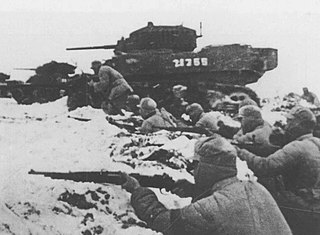 W
WThe Huaihai campaign, or Battle of Hsupeng, was one of the military conflicts in the late stage of the Chinese Civil War between the Kuomintang and the Communist Party of China. The campaign started when the People's Liberation Army (PLA) launched a major offensive against the Kuomintang headquarters in Xuzhou on 6 November 1948, and ended on 10 January 1949 when the PLA reached the north of the Yangtze.
 W
WThe encirclement campaign against the Hunan-Hubei-Jiangxi Soviet was a military campaign launched by the Kuomintang Nationalist Government against the communist Soviet force in the Hunan-Hubei-Jiangxi. It was responded to with the Communists' Counter-encirclement campaign at the Hunan-Hubei-Jiangxi Soviet, also called their Counter-encirclement campaign at the Hunan-Hubei-Jiangxi Revolutionary Base. The local red army successfully defended this soviet republic against the government attacks from December 1930 through to May 1931.
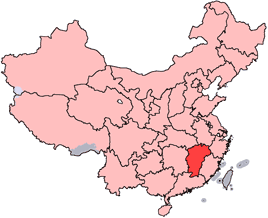 W
WThe first encirclement campaign against Jiangxi Soviet was a series of battles launched by the Chinese Nationalist Government intended to annihilate the Chinese Red Army, and destroy the Chinese Soviet Republic. The communists later responded with the first counter-encirclement campaign at Central Soviet, also called by the communists as the first counter-encirclement campaign at Central Revolutionary Base, in which the Red Army successfully defended the Soviet Republic in the southern Jiangxi province against Nationalist attacks from November 1930 to January 3, 1931.
 W
WThe second encirclement campaign against Jiangxi Soviet was a series of battles launched by the Chinese Nationalist Government in the hope of encircling and destroying the Jiangxi Soviet after the previous campaign had failed. The Red Army repelled the encirclement by launching their second counter-encirclement campaign, also called by the communists as the second counter-encirclement campaign at Central Revolutionary Base, in which the local Chinese Red Army successfully defended the Jiangxi Soviet against the Nationalist attacks from April 1, 1931, to May 31, 1931.
 W
WThe fourth encirclement campaign against the Jiangxi Soviet was the fourth campaign launched by the Chinese Nationalist Government in hope to destroy the Red Army in Jiangxi. The Nationalist headquarters in the provincial border of Jiangxi-Guangdong-Fujian organized nearly 400,000 men, and prepared for another major encirclement on the Chinese Soviet Republic. As a response, the Jiangxi Soviet launched the fourth counter-encirclement campaign at the Central Soviet, also called as the fourth counter-encirclement campaign at the Central Revolutionary Base. Although the Red Army achieved victory once again, their counter encirclement was not as successful as the previous ones this time, and the Red Army elsewhere suffered considerable loss when many other communist bases were lost, including two major ones.
 W
WThe fifth encirclement campaign against Jiangxi Soviet was a series of battles fought during the Chinese Civil War from 25 September 1933, to October 1934 between Chiang Kai-shek's Kuomintang (nationalist) and the Chinese communists. During this campaign, the Kuomintang successfully overran the communist Chinese Soviet Republic and forced the communists on the run, an event later known as the Long March. Chiang Kai-shek and the Kuomintang termed this campaign as the fifth encirclement campaign, whilst the Chinese communists termed it as the fifth counter-encirclement campaign at the Central Soviet, also known as the fifth counter-encirclement campaign at the Central Revolutionary Base or fifth extermination campaign.
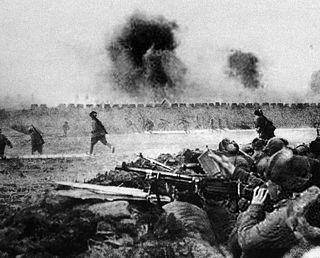 W
WThe Liaoshen campaign, an abbreviation of Liaoning–Shenyang campaign after the province of Liaoning and its Yuan directly administered capital city Shenyang, was the first of the three major military campaigns launched by the Communist People's Liberation Army (PLA) against the Kuomintang Nationalist government during the late stage of the Chinese Civil War. This engagement is also known to the Kuomintang as the Battle of Liaohsi, took place between September and November 1948 and lasted a total of 52 days. The campaign ended after the Nationalist forces suffered sweeping defeats across Manchuria, losing major cities of Jinzhou, Changchun and eventually Shenyang in the process, eventually leading to the capture of the whole of Manchuria by the Communist forces. The victory of the campaign resulted in the Communists achieving strategic numerical advantage over the Nationalists for the first time in its history.
 W
WLinjiang Campaign, also known by the communists as the Campaign of Going South of the River for Three time to Guard Linjiang for Four Times, was a series of four failed offensives launched by the nationalists in an attempt to eliminate the communist base south of the Songhua River during the Chinese Civil War.
 W
WThe Menglianggu campaign was fought between the nationalists and the communists during the Chinese Civil War in the post-World War II era and resulted in communist victory. The campaign was later used by the communists as a specific battle example in their military science and history, as well as a propaganda piece. The battle mainly took place in Menglianggu of Linyi region in Shandong Province.
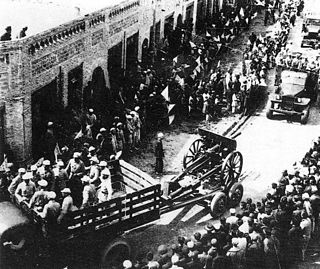 W
WThe Ningxia Campaign was a series of battles fought between the nationalists and the communists during Chinese Civil War in the post World War II era, and resulted in the communist victory.
 W
WThe encirclement campaign against the Northeastern Jiangxi Soviet was a campaign launched by the Chinese Nationalist Government intended to destroy the communist Chinese Soviet Republic and its local military forces. It was met by the Communists' Counter-encirclement campaign at Northeastern Jiangxi Soviet, also called the Counter-encirclement campaign at Northeastern Jiangxi Revolutionary Base. The Nationalist campaign lasted from December 1930 to July 1931, and resulted in the destruction of the target base area.
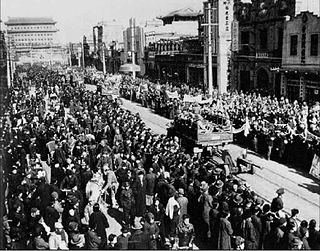 W
WThe Pingjin campaign, also known as the Battle of Pingjin, was part of the three major campaigns launched by the People's Liberation Army during the late stage of the Chinese Civil War against the Nationalist government. It began on 29 November 1948 and ended on 31 January 1949, lasting a total of 64 days. This campaign marked the end of Nationalist dominance in the North China Plain. The term Pingjin refers to the cities Beiping and Tianjin.
 W
WThe second encirclement campaign against the Shaanxi–Gansu Soviet was an encirclement campaign launched by the Chinese Nationalist Government that was intended to destroy the communist Shaanxi–Gansu Soviet and its Chinese Red Army in the local region. It was responded by the Communists' second counter-encirclement campaign at Shaanxi–Gansu Soviet, also called by the communists as the second counter-encirclement campaign at Shaanxi–Gansu Revolutionary Base, in which the local Chinese Red Army successfully defended their soviet republic in the border region of Shaanxi and Gansu provinces against the Nationalist attacks from April 1935 to July, 1935.
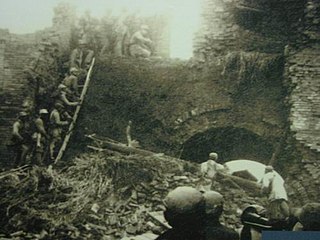 W
WThe Shangdang Campaign was a series of battles fought between the Communist force under the leadership of Liu Bocheng and the nationalist Yan Xishan's Kuomintang force. The Campaign lasted from September 10, 1945, through October 12, 1945. Like all other Chinese Communist victories in the clashes immediately after Imperial Japan's surrender in World War II, the outcome of this campaign altered the course of the peace negotiation held in Chongqing from August 28, 1945, through October 11, 1945, resulting in a more favourable outcome for Mao Zedong.
 W
WThe Battle of Shuangduiji (双堆集战役) was a major campaign fought between the nationalists and the communists during the Chinese Civil War in the post-World War II era, resulting in a communist victory. The campaign was part of the Huaihai campaign.
 W
WThe Campaign to Defend Siping (四平保卫战) was a struggle between the Nationalists and the communists for the control of Siping during the Chinese Civil War in the post World War II era. The nationalists have combined this campaign with the Battle of Siping as part of the battle, but this was rather misleading since the strategies for both sides were totally different from the strategies in this campaign and unrelated to each other, furthermore, the commanders for both sides in this campaign were completely different from the Battle of Siping. More importantly, the nationalists in the Battle of Siping was in name only, because they were former nationalists turned Japanese puppet regime forces who rejoined the nationalists after World War II, and the local bandits recruited by the nationalist administrators to fight off communists, since Chiang Kai-shek's nationalist regime simply did not have the resource to rapidly deploy his forces into the region. In fact, in the Battle of Siping, Chiang's own force did not even participated in the fights. This campaign was characterized by the fact that the supreme commanders of both sides had overestimated their strength and set unrealistic goals that could doom their troops in the field, but in both cases, the brilliant frontline commanders on both sides had successfully averted the potential catastrophes by convincing their respective supreme commanders to change their original decisions.
 W
WThe Taiyuan campaign was a campaign of the Chinese Civil War fought between the nationalist and communist factions. The campaign was over the control of Taiyuan, the capital of the province of Shanxi, China. The campaign resulted in a communist victory.
 W
WThe third encirclement campaign against Jiangxi Soviet was the third campaign launched by the Chinese Nationalist Government in the hope of destroying the Red Army in Jiangxi. It was launched less than a month after the previous campaign failed. However, this encirclement was repelled by the Red Army's third counter-encirclement campaign at the Central Soviet, also called as the third counter-encirclement campaign at the Central Revolutionary Base.
 W
WThe Yangtze River Crossing Campaign was a military campaign launched by the People's Liberation Army to cross the Yangtze River and capture Nanjing, the capital of the Nationalist government of the Kuomintang, in the final stage of the Chinese Civil War. The campaign began at night on 20 April, and lasted until 2 June 1949, concluding after the fall of Nanjing and Shanghai to the Communist forces.